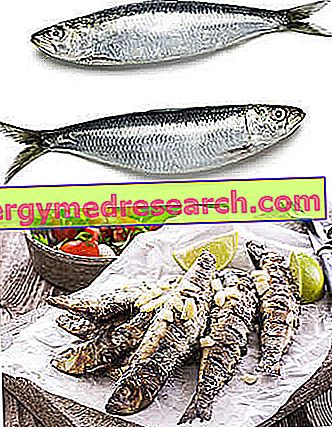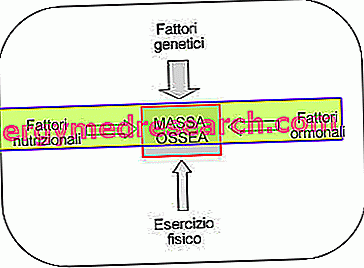What are Sardines
Sardines (or sardines) are animals that belong to the group of fish.

In human nutrition, sardines are included in the set of fishery products and, being part of the first fundamental group of foods, contain above all: high biological value proteins, some vitamins and mineral salts typical of this category.
Despite their nutritional richness, sardines are considered "poor fish" and the most famous recipes are: Sarde Fritte, Sarde Scotta Dito ai Ferri, Sarde in Saor, Sarde Stuffed Ligurian and Sardinian Beccafico.
Pasta with Salted Sardines
X Problems with video playback? Reload from YouTube Go to Video Page Go to Video Recipes Section Watch the video on youtubeNutritional Features
Sardines are foods that do not lend themselves to vegetarian, vegan and Hindu diets; they are instead granted in the kosher and Muslim diet.
| Nutritional composition for 100g of Sardines | ||||||||||||||||||||||||||||||||||||||||||||||||||||||||||||||||||||||||||||||||||||||||||||||||||
 | ||||||||||||||||||||||||||||||||||||||||||||||||||||||||||||||||||||||||||||||||||||||||||||||||||
Nutritional values (per 100 g of edible portion) | ||||||||||||||||||||||||||||||||||||||||||||||||||||||||||||||||||||||||||||||||||||||||||||||||||
| ||||||||||||||||||||||||||||||||||||||||||||||||||||||||||||||||||||||||||||||||||||||||||||||||||
Sardines have a medium energy supply and are not part of the lean fish category; on the other hand, avoiding the use of oil to dress them it is possible to take them in the same quantities (for example) as sea bass and sea bream. This clarification is not accidental and aims to sensitize readers towards a greater consumption of sardines in the diet. In fact, from the qualitative point of view, in addition to representing a considerable economic saving, eating sardines instead of any other white farmed fish significantly increases the intake of certain nutrients (including above all omega 3).
Sardinian calories come essentially from proteins, followed by lipids and very few simple carbohydrates. They have a medium cholesterol concentration and do not contain fiber. Peptides have a high biological value and predominantly polyunsaturated fatty acids (with great importance of essential omega 3 polyunsaturated fats).
The prevalent vitamins in sardines are: niacin (vit PP), vit A (retinol) and, although not shown in the table, vitamin D or calciferol.
As far as mineral salts are concerned, potassium, iron, phosphorus and iodine abound (detail not shown in the table).
The sardines are suitable for any type of diet even if, like most foods, the relative portion should be adapted to the possible condition of overweight.
The good concentration of essential fatty acids of the omega 3 group favors the normalization of lipemia (especially cholesterolemia and triglyceridemia), tends to improve primary arterial hypertension and prevents some complications related to type 2 diabetes mellitus.
It must be specified that, due to the probable presence of anisakis (parasite), the sardines cannot be eaten raw if not reduced in temperature. After cooking, these organisms are totally eliminated but, to keep the omega 3 levels intact, frying should be avoided.
The average portion of sardines is 200-250g (260-320kcal).
Description and Biology
Sardines are called bony fish (osteitti) because, differently from condroitti (cartilaginous fish like sharks), they have a skeleton composed of hydroxyapatite (calcium, phosphorus and collagen).
They have a sub-cylindrical shape characterized by a more rounded belly as they increase in size of the specimen. The back is bluish or greenish, the sides are characterized by some black specks and the belly seems almost white; the whole livery is characterized by a great brilliance. The scales are wide and the mouth is very wide. It reaches a maximum length of 27-30cm.
Sardines are typical organisms of the Mediterranean Sea, the Black Sea and the Central-North Atlantic Ocean (limited to the European and African continents). They have seasonal pelagic habits; they usually live between 25-55 meters deep in daylight hours and date back up to 10-35 meters in the night ones. In the Mediterranean, they approach near the coast only in the summer period, while in winter they also reach depths exceeding 100m.
Sardines feed on phytoplankton (in the larval state) and zooplankton or other small organisms; on the other hand, they are eaten by a huge variety of predators: other fish (tuna, sharks, rays, bonito, lampughe, greenhouse, amberjack, lecce, needlefish, mackerel, lanzardi, alletterati etc.), marine mammals (dolphins, humpback whales etc) and birds (gulls, cormorants, etc.).
Sardines are subject to a rather intense fishing and, despite their capacity to lay up to 80, 000 eggs per specimen, they are progressively decreasing in population. What's worse is that, in addition to being caught with great intensity, they are often disposed of without even reaching the fish stalls because of their unsustainable selling price for professionals.



